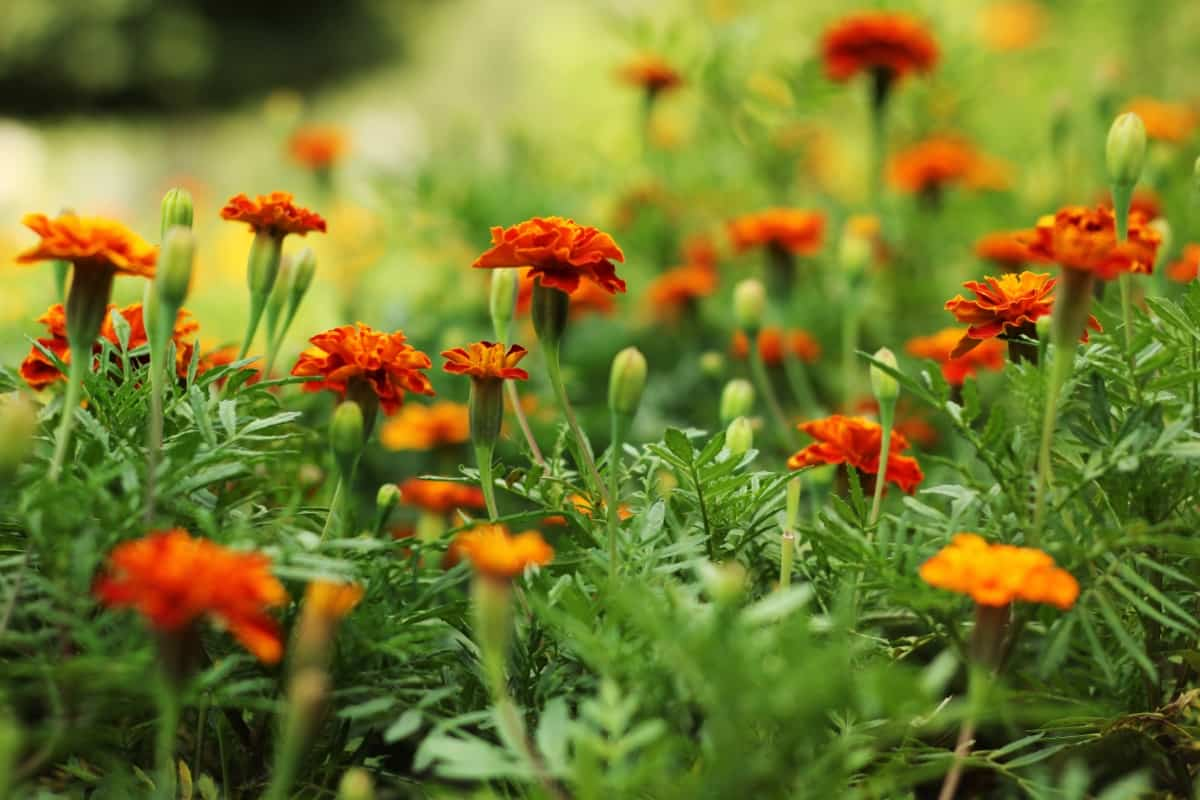Welcome to our blog post on Common Marigold Plant Pests! Marigolds, with their fabulous blooms and diverse varieties, are lovely additions to gardens, but like any plant, they can be prone to a range of common pests that can hinder their beauty and health. This blog post aims to discuss 10 of the most common marigold pests, including their symptoms, treatments, prevention, and management. So, get ready to explore these marigold plants’ ten most common pests.

Common Marigold Plant Damaging Pests
Important Points for Beginners to Identify and Manage Pests in Marigold Plants
- Identifying the pest: The first step is identifying the pest infesting your marigold plant so that you can approach it with the most effective control method.
- Regular Monitoring: Monitor your Marigold plants regularly for signs of pests. This will help you to identify an infestation early when it is easier to control.
- Sanitation: Remove the infected plant debris and burn them.
- Natural Control: Several natural control methods can help to manage pests. These include plant extracts, essential oils, predators, and organic insecticides.
- Chemical Control: If natural controls are ineffective, use insecticides as a last resort, and follow the label instructions and dosage carefully.
Aphid Pest in Marigold Plant
- Damage Symptoms by Neotoxoptera oliveri: Aphids extract the sap from plant tissues, causing stunted plant growth or distorted flowers. Infested leaves exhibit wilting, curling, and chlorosis. Aphids excrete sugary honeydew as a byproduct of their feeding, promoting the growth of black sooty mold.
- Survival and Spread: Aphids prefer moderate temperatures and high humidity of 15-27°C for their growth and development. High humidity facilitates their feeding and reproduction. They prefer actively growing, particularly succulent plant tissues.
- Treatment, maintenance, and Control Measures: Spray bifenthrin, cypermethrin, deltamethrin, malathion, chlorpyrifos, dimethoate, methyl demeton, monocrotophos, phosphomidon, imidacloprid, thiamethoxam, clothianidin, and acetamiprid.
Thrips Pest in Marigold Plant
- Damage Symptoms by Thrips tabaci: Thrips feed on the upper surface of marigold leaves and cause a stippled or speckled appearance called silvering or whitening. The affected plants may show twisting and curling in leaves, scarring on petals, and deformed flowers.
- Survival and Spread: Thrips prefer warm and dry environments of 20-30°C for survival and reproduction. Dense canopy and poor airflow provide hiding places and shelter for thrips, allowing them to multiply and move between plants easily.
- Treatment, maintenance, and Control Measures: Spray imidacloprid, acetamiprid, thiamethoxam, acephate, chlorpyrifos, bifenthrin, cypermethrin, deltamethrin, spinosad, methoxyfenozide, and diflubenzuron.
Slug Pest in Marigold Plant
- Damage Symptoms by Deroceras reticulatum: Slugs feed by scraping and chewing on the leaves of marigold plants. Slugs produce slimy mucus as they move across plant surfaces. The affected leaves show wilting, chlorosis, and stunted growth.
- Survival and Spread: Slugs prefer moderate temperatures and damp climates of 10-20°C for reproduction and increased pest activity. They prefer areas with ample organic matter, shade, and dense vegetation, such as decaying leaves or plant debris.
- Treatment, maintenance, and Control Measures: Spray metaldehyde, iron phosphate, copper sulfate, and copper oxychloride.
Leaf Miner Pest in Marigold Plant
- Damage Symptoms by Liriomyza trifolii: Leaf miners create distinct serpentine or winding mines on the surface of the leaves. These mines appear as thin, white, or yellowish lines. The affected leaves show discoloration, deformation, stunted growth, and premature leaf drop.
- Survival and Spread: Leaf miners prefer warm temperatures of 20-30°C and high humidity. They prefer plants in the vegetative growth stage. Plant stresses and nutrient deficiencies provide an ideal environment for leaf miners to feed and reproduce.
- Treatment, Maintenance, and Control Measures: Spray bifenthrin, cypermethrin, malathion, spinetoram, spinosad, abamectin, triazophos, monocrotophos, imidacloprid, acetamiprid, indoxacarb, and thiamethoxam.
Red Spider Mite Pest in Marigold Plant
- Damage Symptoms by Tetranychus urticae: Red spider mites feed on the plant’s chlorophyll, causing yellow or bronze spots. The affected leaves show signs of stippling, webbing, curling, distortion, and premature leaf drop.
- Survival and Spread: Red Spider Mites prefer warm and dry conditions of 27-30°C for survival and reproduction. A dense canopy and poor air circulation provide a conducive environment for the mites.
- Treatment, Maintenance, and Control Measures: Spray abamectin, bifenazate, spiromesifen, metasystox, dicofol, rogor, fenazaquin, nuvacron, bifenthrin, kelthane, and dimethoate.
In case you missed it: 10 Common Marigold Plant Damaging Diseases: Symptoms, Treatment, Prevention, and Management

Leaf Hopper Pest in Marigold Plant
- Damage Symptoms by Empoasca fabae: Leafhoppers feed on plant sap, causing stippling or white speckling. The affected plants may show chlorosis, curling, defoliation, reduced flowering, and stunted growth.
- Survival and Spread: Leaf folders prefer warm and moist climates of 25-30°C for survival and reproduction. Monoculture, weeds, plant debris, high plant density, and poor airflow provide a conducive environment for pests.
- Treatment, Maintenance, and Control Measures: Spray bifenthrin, cypermethrin, deltamethrin, imidacloprid, acetamiprid, malathion, chlorpyrifos, carbaryl, dimethoate, methyl parathion, quinalphos, and diflubenzuron.
Hairy Caterpillar Pest in Marigold Plant
- Damage Symptoms by Diacrisia oblique: Hairy caterpillars feed voraciously on the leaves, causing severe defoliation. They consume the green tissue between the veins, causing the leaves to appear skeletonized or have a sparse leaf canopy. They excrete black or dark brown pellets called frass or droppings.
- Survival and Spread: Hairy caterpillars prefer warm and moist environments of 25-30°C for reproduction and survival. Overcrowded plants, prolonged leaf wetness, monoculture, and leafy vegetation create a conducive environment.
- Treatment, Maintenance, and Control Measures: Spray spinosad, cypermethrin, deltamethrin, thiodan, imidacloprid, acephate, carbaryl, malathion, nuvan, acetamiprid, and chlorpyrifos.
Whitefly Pest in Marigold Plant
- Damage Symptoms by Bemisia tabaci: Whiteflies extract sap from the leaves and excrete sticky honeydew that promotes sooty mold. Infested plants exhibit yellowing, wilting, curling, deformed leaves, and reduced flowering, especially in the lower parts of the plant.
- Survival and Spread: Whiteflies prefer warm and mild humid environments of 20-30°C and >50% humidity for their growth and survival. They prefer plants in their vegetative growth stage, as they provide tender new leaves and shoots rich in nutrients.
- Treatment, Maintenance, and Control Measures: Spray bifenthrin, cypermethrin, permethrin, malathion, chlorpyrifos, imidacloprid, acetamiprid, fipronil, diflubenzuron, dinotefuran, and thiamethoxam.
Mealybug Pest in Marigold Plant
- Damage Symptoms by Phenacoccus solenopsis: Mealybugs are covered in a white, cottony wax that serves as protection which is the most recognizable sign of its presence. They feed on the sap and excrete honeydew. Infected leaves show chlorosis, wilting, distorted, and premature leaf drop.
- Survival and Spread: Mealybugs prefer warm and humid environments of 20-30°C and >60% humidity for reproduction and survival. High plant density and poor airflow create a conducive environment for the pest.
- Treatment, Maintenance, and Control Measures: Apply imidacloprid, acetamiprid, malathion, chlorpyrifos, bifenthrin, cypermethrin, permethrin, spirotetramat, and dinotefuran.
Weevil Pest in Marigold Plant
- Damage Symptoms by Calomycterus setarius: Weevils have a distinctive feeding habit of feeding on and notching the edges of leaves, giving the leaves a ragged appearance. They feed on the developing buds, causing them to deform or fail to open properly. Infected plants show signs of chewing, wilting, chlorosis, and stunted growth.
- Survival and Spread: Weevils prefer warm and humid environments of 20-30°C for feeding, reproduction, and survival. Excessive moisture and waterlogged conditions create a conducive environment for the pest.
- Treatment, Maintenance, and Control Measures: Spray bifenthrin, cypermethrin, permethrin, deltamethrin, imidacloprid, clothianidin, malathion, and chlorpyrifos.
In case you missed it: Common Rose Plant Damaging Diseases: Symptoms, Treatment, Prevention, and Management

Conclusion
Common marigold plant pests include aphids, thrips, slugs, leaf miners, red spider mites, leaf hoppers, hairy caterpillars, whiteflies, mealybugs, and weevils. By identifying the pest, inspecting plants regularly, and using natural control methods, you can help to keep your marigold plants healthy and beautiful.
- Beneficial Insects in Pest Management
- Natural Solutions for Pest Control in Flower Gardens
- Types of Fungicides Used in Agriculture
- Common Issues in the Fruit Development Stage of Pomegranate Farming
- Fruit Development Issues in Papaya: Easy Solutions and Treatment
- Soil-Borne Diseases and How to Protect Your Plants
- Practices to Prevent Disease Spread in the Garden
- From Wilted to Thriving: How to Treat Root Rot Naturally in Houseplants
- Natural Remedies to Cure Brown Spots on Fig Tree Leaves